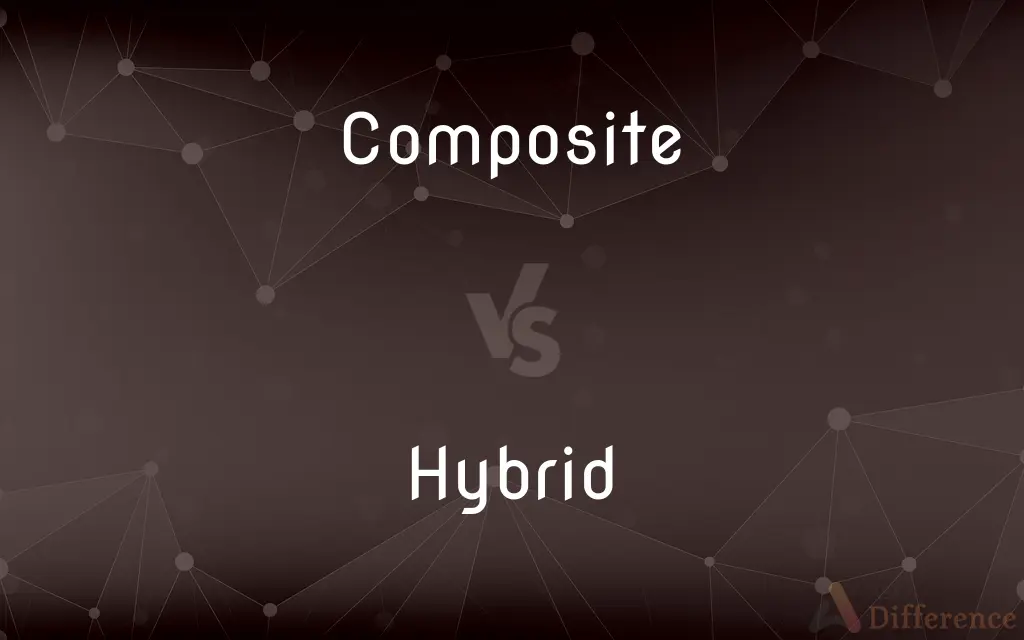Composite vs. Hybrid — What's the Difference?
By Tayyaba Rehman & Urooj Arif — Updated on April 24, 2024
Composite materials are made from two or more constituents with different physical or chemical properties, whereas hybrids combine characteristics of different elements across any domain.

Difference Between Composite and Hybrid
Table of Contents
ADVERTISEMENT
Key Differences
A composite material is designed by combining two or more different materials to create a new material with superior properties, such as increased strength, lighter weight, or resistance to environmental conditions. On the other hand, a hybrid generally refers to something that mixes elements from different sources or categories, which can be in technology, biology, or products, enhancing functionality or performance by merging distinct characteristics.
Composites are often used in structural applications where high strength-to-weight ratios are crucial, such as in aerospace and automotive industries. Whereas hybrids are commonly found in products like hybrid cars, which combine internal combustion engines with electric power to offer fuel efficiency and reduced emissions.
The manufacturing process of composites involves embedding fibers like glass or carbon in a matrix of resin, which provides the structural reinforcement. In contrast, hybrid technologies or products integrate different mechanisms, systems, or materials to function together, optimizing overall performance.
Composites are specifically engineered for their mechanical and physical properties, focusing on performance enhancements in specific applications. Hybrids, however, may focus on broader goals such as efficiency, cost-effectiveness, or user preferences across various fields including energy, transportation, and consumer electronics.
While composites are primarily discussed in the context of materials science, hybrids can be discussed across a wider range of fields, including genetics, where hybrid species are created through crossbreeding to combine desirable traits of both parents.
ADVERTISEMENT
Comparison Chart
Definition
Material made from two or more different substances.
Combination of different elements or technologies.
Usage
Structural applications in industries.
Broad, including vehicles, plants, and technologies.
Focus
Enhancing mechanical properties.
Enhancing functionality, efficiency, or diversity.
Examples
Carbon fiber reinforced plastics.
Hybrid cars, hybrid animals, hybrid clouds.
Typical Properties
High strength-to-weight ratio.
Combines features to achieve optimal performance.
Compare with Definitions
Composite
A material made from two or more constituent materials with significantly different physical or chemical properties.
Fiberglass is a composite made of glass fibers embedded in a resin matrix.
Hybrid
Used to enhance efficiency, functionality, or adaptability.
Hybrid cloud solutions combine public and private cloud services to optimize data management and security.
Composite
They retain the identities of their constituents while offering superior properties.
Concrete is a composite that combines aggregate with cement to provide robust structural materials.
Hybrid
A combination of two different types of technologies, species, or systems.
A hybrid car uses both gasoline and electric power to operate.
Composite
Often used in construction and manufacturing due to its strength and lightweight.
Carbon fiber composites are prevalent in the manufacture of modern airplanes.
Hybrid
Often refers to biological hybrids resulting from the crossbreeding of different species.
Mules are hybrids born from a horse and a donkey.
Composite
Focus on physical and mechanical enhancements.
Composite materials are crucial in high-performance sports equipment for improved efficacy.
Hybrid
Focuses on integrating the best features of its components.
Hybrid seeds are developed to improve crop yield and disease resistance.
Composite
Typically engineered to meet specific performance requirements.
Composite baseball bats are designed to enhance hitting power and durability.
Hybrid
In technology, refers to systems that combine multiple functionalities.
Hybrid laptops can function as both a laptop and a tablet.
Composite
Made up of several parts or elements
This soup is one of those composite dishes which you gradually build up
Hybrid
(Genetics) The offspring of genetically dissimilar parents or stock, especially the offspring produced by breeding plants or animals of different varieties, species, or races.
Composite
Relating to or denoting a classical order of architecture consisting of elements of the Ionic and Corinthian orders.
Hybrid
Something of mixed origin or composition, such as a word whose elements are derived from different languages.
Composite
Relating to or denoting plants of the daisy family (Compositae ).
Hybrid
Something having two kinds of components that produce the same or similar results, such as a vehicle powered by both an electric motor and an internal combustion engine as sources of power for the drivetrain.
Composite
A thing made up of several parts or elements
The English legal system is a composite of legislation and judicial precedent
Hybrid
(biology) Offspring resulting from cross-breeding different entities, e.g. two different species or two purebred parent strains.
Composite
A plant of the daisy family (Compositae ).
Hybrid
Something of mixed origin or composition; often, a tool or technology that combines the benefits of formerly separate tools or technologies.
Composite
The Composite order of architecture.
Hybrid
(linguistics) A word whose elements are derived from different languages.
Composite
Combine (two or more images) to make a single picture
Photographic compositing by computer
Hybrid
A hybrid vehicle (especially a car), one that runs on both fuel (gasoline/diesel) and electricity (battery or energy from the sun).
All our family drive hybrids because they're greener.
Composite
Made up of distinct components; compound.
Hybrid
(cycling) A bicycle that is a compromise between a road bike and a mountain bike.
Composite
Made by combining two or more existing things, such as photographs.
Hybrid
(golf) A golf club that combines the characteristics of an iron and a wood.
Composite
(Mathematics) Having factors; factorable.
Hybrid
An electronic circuit constructed of individual devices bonded to a substrate or PCB.
Composite
(Botany) Of, belonging to, or characteristic of the composite family.
Hybrid
A computer that is part analog computer and part digital computer.
Composite
Composite(Architecture) Of, relating to, or being in the Composite order.
Hybrid
Consisting of diverse components.
A hybrid mix of jazz and punk
Composite
A structure or entity made up of distinct components
A musical suite that is a composite of operatic themes.
Hybrid
(of a car) Running on both fuel (gasoline/diesel) and electricity (battery or energy from the sun).
Composite
A material in which two or more distinct, structurally complementary materials, usually a matrix material and a reinforcing material, are combined to produce structural or functional properties not present in any individual component. Wood, bone, concrete, plastic reinforced by glass fibers, and graphite reinforced with carbon fibers are all composite materials.
Hybrid
The offspring of the union of two animals or plants derived from recognizably different genetic lines, as two distinct species, or two strains of the same species with known genetic differences; an animal or plant produced from the mixture of two genetic lines. See Mongrel.
Composite
(Botany) A plant in the composite family.
Hybrid
A word composed of elements which belong to different languages.
Composite
(Mathematics) The application of one function to another. For example, if (x) = x2 and g(x) = x + 1, then the composite (g(x)) = (x + 1)2 and the composite g((x)) = x2 + 1.
Hybrid
Anything derived by a mixture of components or characteristics from two distinctly different sources; as, a musical hybrid; a DNA-RNA hybrid.
Composite
To make using distinct components.
Hybrid
Produced from the mixture of two genetically distinct strains; as, plants of hybrid nature.
Composite
To make by combining two or more photographs or images.
Hybrid
Derived by a mixture of characteristics from two distinctly different sources; as, a hybrid musical style; a hybrid DNA molecule.
Composite
Made up of multiple components; compound or complex.
Hybrid
A word that is composed of parts from different languages (e.g., `monolingual' has a Greek prefix and a Latin root)
Composite
(architecture) Being a mixture of Ionic and Corinthian styles.
Hybrid
A composite of mixed origin;
The vice-presidency is a hybrid of administrative and legislative offices
Composite
(mathematics) Having factors other than itself and one; not prime and not one.
Hybrid
An organism that is the offspring of genetically dissimilar parents or stock; especially offspring produced by breeding plants or animals of different varieties or breeds or species;
A mule is a cross between a horse and a donkey
Composite
(botany) Belonging to the Asteraceae family (formerly known as Compositae), bearing involucrate heads of many small florets.
Hybrid
Produced by crossbreeding
Composite
Employing multiple exposures on a single plate, so as to create an average view of something, such as faces in physiognomy.
Composite portraiture; a composite photograph
Composite
A mixture of different components.
Composite
A structural material that gains its strength from a combination of complementary materials.
Composite
(botany) A plant belonging to the family Asteraceae, syn. Compositae.
Composite
(mathematics) A function of a function.
Composite
(mathematics) composite number
Composite
A drawing, photograph, etc. that combines several separate pictures or images.
Composite
A railway carriage with compartments for two different classes of travel; see Composite Corridor.
Composite
To make a composite.
I composited an image using computer software.
Composite
Made up of distinct parts or elements; compounded; as, a composite language.
Happiness, like air and water . . . is composite.
Composite
Belonging to a certain order which is composed of the Ionic order grafted upon the Corinthian. It is called also the Roman or the Italic order, and is one of the five orders recognized by the Italian writers of the sixteenth century. See Capital.
Composite
Belonging to the order Compositæ; bearing involucrate heads of many small florets, as the daisy, thistle, and dandelion.
Composite
That which is made up of parts or compounded of several elements; composition; combination; compound.
Composite
A conceptual whole made up of complicated and related parts;
The complex of shopping malls, houses, and roads created a new town
Composite
Considered the most highly evolved dicotyledonous plants, characterized by florets arranged in dense heads that resemble single flowers
Composite
Consisting of separate interconnected parts
Composite
Of or relating to or belonging to the plant family Compositae
Composite
Used of color
Composite
A modified Corinthian style of architecture (a combination of Corinthian and Ionic)
Common Curiosities
What defines a hybrid?
A hybrid refers to any combination of different elements, technologies, or species that result in a new entity with combined characteristics.
What is a composite material?
A composite material is made by combining two or more materials with different properties to create a new material with enhanced characteristics.
How are composites different from hybrids?
Composites strictly refer to materials made from two distinct substances to enhance mechanical properties, while hybrids can refer to a broader range of combinations in various fields.
What are common examples of composites and hybrids?
Common composites include reinforced concrete and fiberglass, while hybrids include hybrid cars, hybrid animals, and hybrid plants.
How do composites impact environmental sustainability?
Composites can contribute to sustainability by reducing weight and increasing the longevity of products, which in turn can lead to less resource consumption and lower emissions.
Can a hybrid be a type of composite?
Technically, hybrids can include composites if they combine material characteristics, but generally, hybrids encompass a wider range of elements beyond just materials.
What is the future of composite materials?
The future of composite materials looks promising with ongoing advancements aimed at developing even lighter and stronger materials for a variety of applications.
What advancements are being made in hybrid technologies?
Advances in hybrid technologies continue to focus on integrating renewable energy sources and improving digital infrastructures to support smarter, more efficient systems.
Are hybrid technologies cost-effective?
Hybrid technologies can be cost-effective by optimizing energy use and reducing operational costs, although initial investments may be higher.
Why are composites important in industries?
Composites are valued in industries for their strength, lightweight, and resistance to environmental damage, enhancing the performance and longevity of products.
What role do composites play in modern construction?
In modern construction, composites are used to improve the structural integrity of buildings and other structures, often leading to safer and more durable constructions.
What are the benefits of hybrids in technology?
Hybrids in technology, such as hybrid cars or hybrid computers, combine the best features of different systems to improve performance, efficiency, and user experience.
Can hybrids exist in digital technologies?
Yes, digital hybrids include solutions like hybrid cloud systems that combine the features of public and private clouds to maximize efficiency and security.
How do hybrids enhance biological diversity?
Biological hybrids can enhance diversity by introducing new genetic combinations that may result in increased vigor and adaptability.
How do composites and hybrids compare in terms of innovation?
Both composites and hybrids drive innovation in their respective fields by pushing the boundaries of what is possible in material science and technology integration, respectively.
Share Your Discovery

Previous Comparison
Intramodal vs. Intermodal
Next Comparison
Advocate vs. SolicitorAuthor Spotlight
Written by
Tayyaba RehmanTayyaba Rehman is a distinguished writer, currently serving as a primary contributor to askdifference.com. As a researcher in semantics and etymology, Tayyaba's passion for the complexity of languages and their distinctions has found a perfect home on the platform. Tayyaba delves into the intricacies of language, distinguishing between commonly confused words and phrases, thereby providing clarity for readers worldwide.
Co-written by
Urooj ArifUrooj is a skilled content writer at Ask Difference, known for her exceptional ability to simplify complex topics into engaging and informative content. With a passion for research and a flair for clear, concise writing, she consistently delivers articles that resonate with our diverse audience.














































